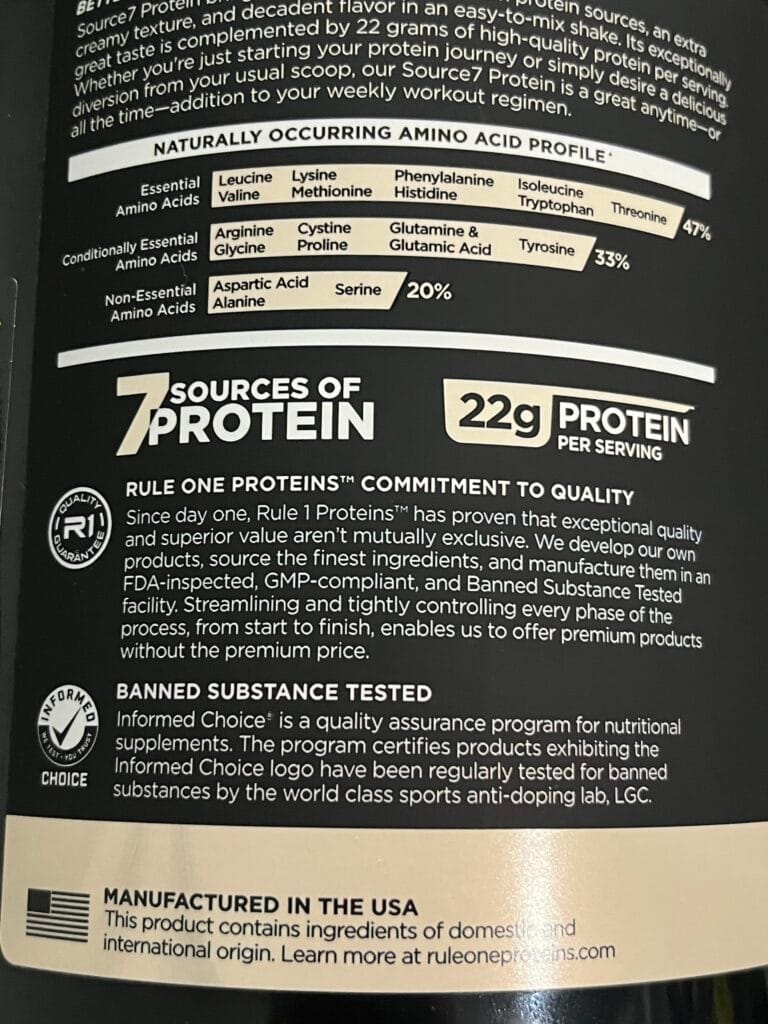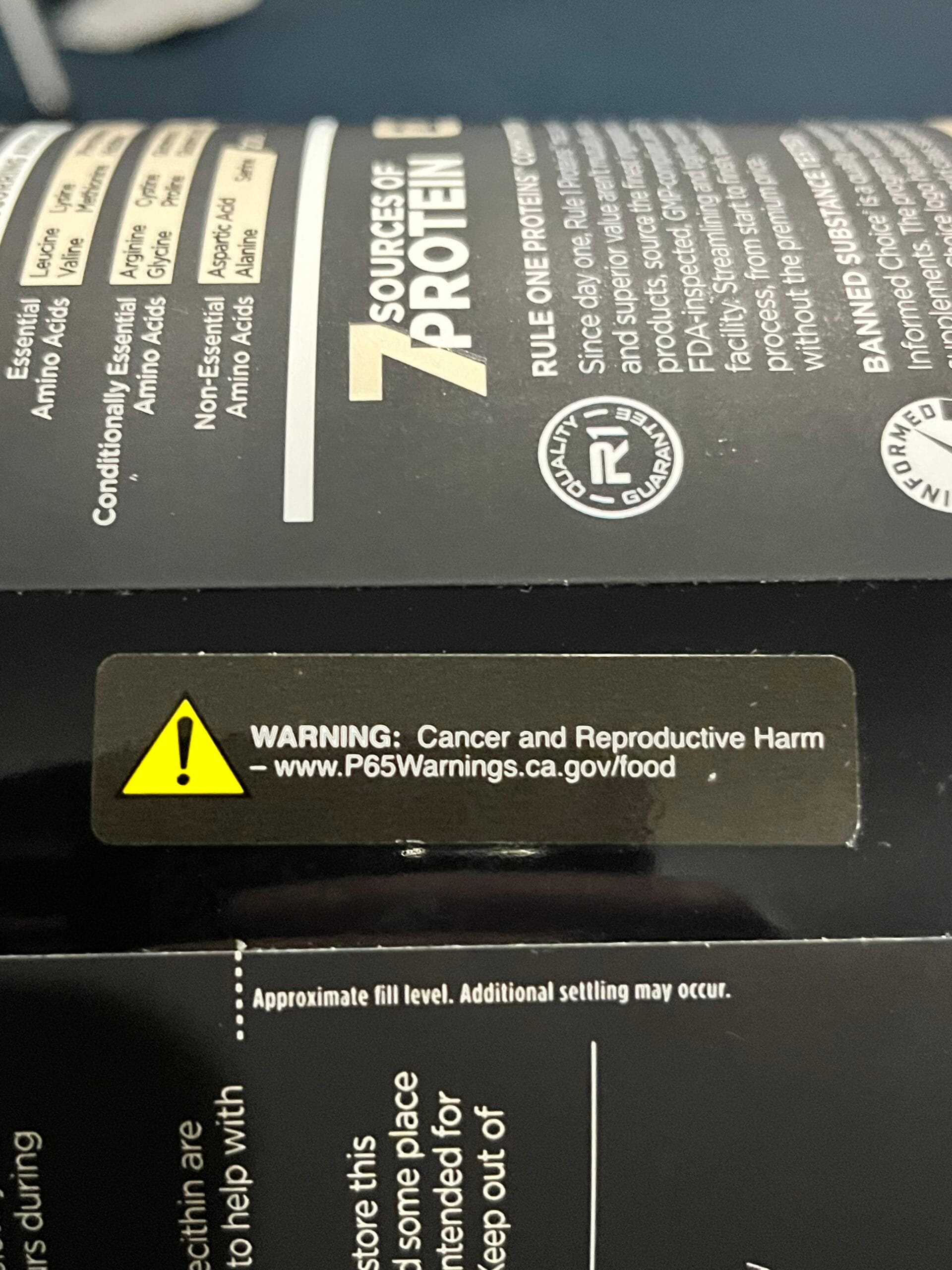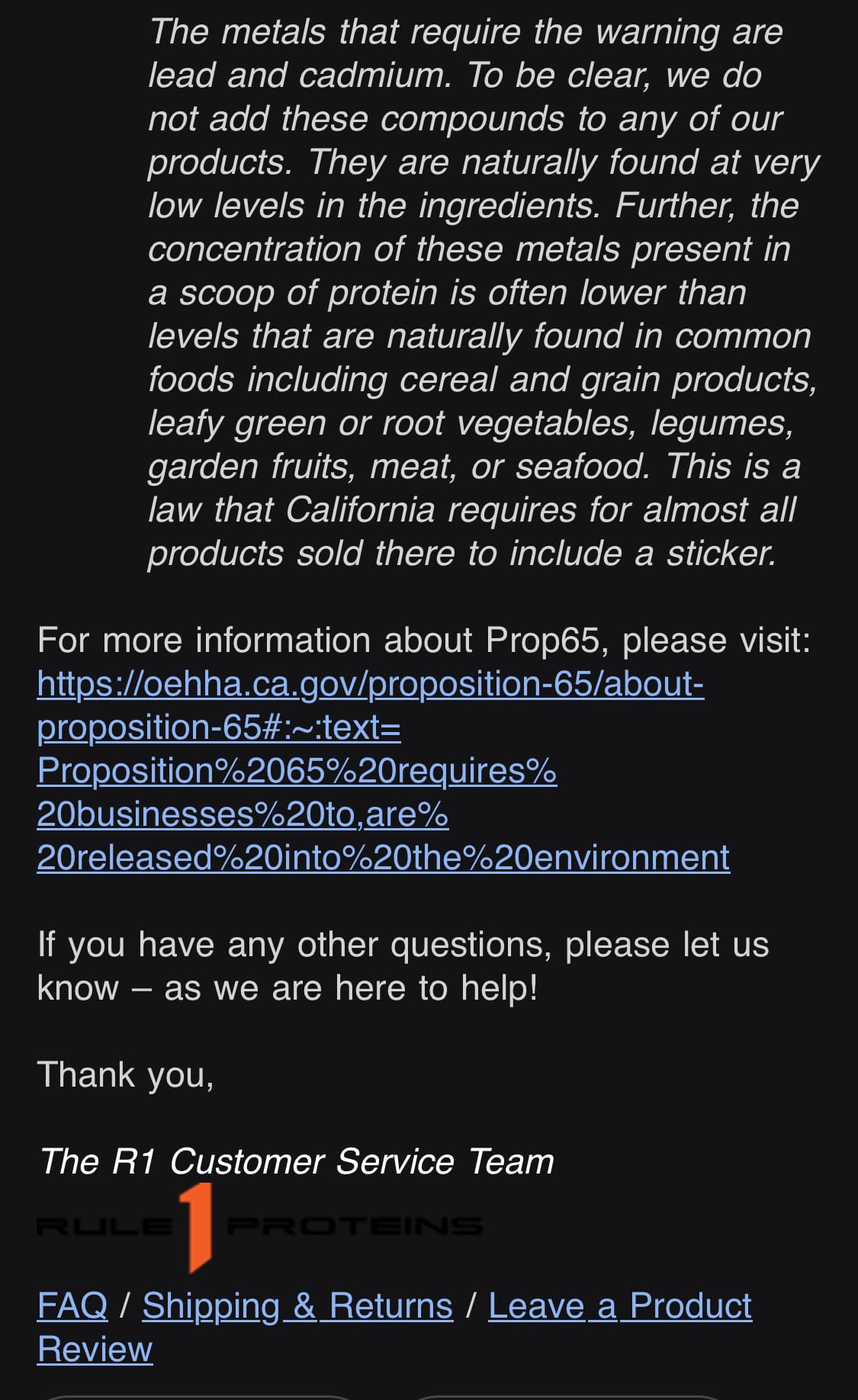Is Rule 1 Protein Safe?
Are Rule 1 proteins safe? Without third-party protein testing or complete disclosure of heavy metal testing, consumers lack the information to be informed buyers. Keep reading to find out if you’re getting a quality protein and a dose of heavy metals that trigger a Prop 65 Warning.
Is Rule 1 Protein Safe? TL;DR
Rule 1 proteins are likely safe for healthy adults, but the brand doesn’t make test results publicly available, citing proprietary information. Rule 1 Proteins carry a California Proposition 65 warning, which means the whey use exceeds NSRL/MADL limits. Rule 1 does not share amino acid profiles and leucine content ,leaving buyers without the information needed to evaluate protein quality or rule out amino padding. In short, Rule 1 isn’t “unsafe,” but it is unverified—and when safety depends on transparency, the missing data speaks louder than the marketing.
What “Safe” Actually Means With Whey Protein
Most consumers use the word “safe” because they don’t know the technical vocabulary. What they’re really asking is whether the brand discloses heavy-metal testing that meets California Proposition 65 standards. Prop 65 matters because it requires companies to warn consumers when products exceed the state’s strict thresholds for lead, cadmium, and other regulated chemicals. When a protein powder carries a Prop 65 warning—as Rule 1 Proteins do—it signals that the brand uses whey protein (or other ingredients) that exceed the NSRL or MADL safety limits.
Whey protein safety depends on heavy-metal content, third-party purity testing, ingredient disclosure, absence of amino spiking, and adherence to FDA labeling laws. When a company chooses not to disclose any of this, it doesn’t automatically make the product dangerous, but it does make it unverified. And in a post–Prop 65 world, unverified proteins create uncertainty for buyers who simply want transparency.
Does Rule 1 Protein Have a Proposition 65 Warning?
Yes. Several Rule 1 proteins carry a California Proposition 65 warning, indicating that the product may contain trace amounts of heavy metals, such as lead, cadmium, or arsenic, above California’s extremely strict reporting thresholds. A Prop 65 warning doesn’t automatically mean a product is dangerous; it indicates that the company uses whey (or other ingredients) that exceed NSRL (No Significant Risk Level) or MADL (Maximum Allowable Dose Level).

Transparent brands typically make those reports publicly available. Rule 1 does not. And when a company opts for the warning instead of the data, it shifts the burden of trust onto the consumer—precisely why “Is Rule 1 protein safe?” is a question people ask in the first place.
Does Rule 1 Publish Third-Party Testing or Heavy Metal Reports?
No. Rule 1 does not publish any batch-level heavy-metal test results, Prop 65 disclosures, or full third-party purity testing. They do have Informed Choice certification on some formulas, but that certification primarily screens for banned substances—not protein purity, heavy metals, or amino acid accuracy. There is a difference between checking what should not be in the product and proving what actually is. Brands like AGN Roots and NorCal Organic Whey publish heavy-metal reports and amino acid profiles publicly. Rule 1 does not. When a company wants you to believe in quality without showing the receipts, you’re expected to take the label at its word. That’s not verification. That’s marketing.
Is Rule 1 Informed Choice or NSF Certified?

Some Rule 1 products carry the Informed Choice logo, indicating their facility and batches are screened for banned substances. However, Informed Choice is not a comprehensive quality certification for protein integrity. It does not verify protein-per-serving accuracy, heavy-metal levels, amino acid completeness, or ingredient transparency, which are crucial for assessing safety and quality.
NSF Certified for Sport goes further, but Rule 1 is not NSF Certified for Sport. Instead, they rely on cGMP claims stamped on every container. cGMP is a baseline manufacturing standard—not proof of purity. It tells you the building is clean, not that the product is clean. Without disclosing heavy-metal or amino test results, Rule 1 remains a brand that says “trust us” instead of “here is the data.”
Are There Ingredients or Processes That Raise Safety Concerns?
Yes, because the lack of transparency opens the door to them. Rule 1 often uses blends, and it is in blended formulas that amino padding has historically occurred. They list “natural and artificial flavors,” which is legal, but flavor systems can contain undisclosed amino acids under FDA 21 CFR 101.22.
They do not disclose leucine content, which is the single best indicator of protein quality. Their protein density is lower than that of top isolates, suggesting the formula may not be as clean as the label implies. None of these factors makes the product dangerous, but they absolutely make it harder to trust. A safe protein should reveal more than it hides.

Does Rule 1 Show Any Signs of Amino Spiking?
Rule 1 does not provide a full amino acid profile, which is the most reliable way to prove that a product is not amino-spiked. Without that table, the consumer has no way to confirm leucine yield, total essential amino acids, or the true quality of the blend. Lower protein density, undisclosed amino composition, and opaque blends are classic traits of products vulnerable to amino padding. This doesn’t mean Rule 1 commits amino spiking—but it means you cannot confirm they don’t. And that uncertainty is exactly why this question exists.
Final Verdict: Is Rule 1 Protein Actually Safe?
Rule 1 protein is likely safe for healthy adults, but the brand does not provide documentation confirming its purity. The absence of heavy-metal testing, undisclosed amino acid profiles, and no third-party purity reports leaves consumers with avoidable blind spots. Several Rule 1 products, including Source7, also carry a California Proposition 65 warning indicating that the product may contain trace levels of lead, cadmium, or other chemicals regulated under Prop 65. A Prop 65 label does not automatically mean a product is unsafe. Still, it does reveal one important fact: Rule 1 has not provided verified test results showing their levels fall below the NSRL/MADL safety thresholds.
Brands earn trust by publishing heavy-metal results, amino profiles, and certified third-party lab data. Rule 1 chooses not to. The result isn’t a verdict of “unsafe,” but rather “unverified”—and unverified supplements ask buyers to trust marketing rather than data. When safety depends on transparency, Rule 1 has not shown enough.
If you want more information on supplement brands, check out my Whey Protein Brand review page. If you want more information about Rule 1 Protein, check out these pages:
- Does Rule 1 Amino Spike?
- Rule 1 Whey Blend Review
- Rule1 Source7 Review
- R1 Pro6 Protein Review
- R1 Protein Isolate Review
Sources for Is Rule 1 Protein Safe?
Office of Environmental Health Hazard Assessment. (n.d.). About Proposition 65. California Environmental Protection Agency. https://oehha.ca.gov/proposition-65/about-proposition-65
Martineau, P. (2025, October 22). Protein powders and shakes contain high levels of lead. Consumer Reports. https://www.consumerreports.org/lead/protein-powders-and-shakes-contain-high-levels-of-lead-a4206364640/
Our story. (n.d.). Rule One Proteins. https://www.ruleoneproteins.com/pages/our-story




Leave a Reply